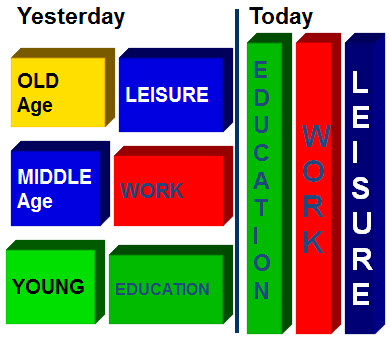I remember an upbeat, if not simplistic, marketing message from yesteryear (and still out there), that life was sequential. First we work, then we enjoy the fruits of our labour; “Freedom at 55”. Today, our approach to work and aging is changing. Look at this graphic, via thought leader, Age Wave:
Older workers are remaining older workers, longer. Advantages go to organizations that hire and retain older workers. Older workers increase the collaborative potential of an organization. Older workers want to continue learning, and like everyone else, have some fun along the way.
HR and The Five Generation Workplace
Yet, with up to five generations in the same workplace, putting boundaries on who ‘best to do what’ is a challenge, not to mention the relationship dynamics between generations. (I found Generations, Inc. a helpful read on that front. It’s written by a father-daughter team)
HR’s (Human Resources) function is intersectional, mediative; i.e., critical to organizational health. In many ways, HR leaders are “guardians of the future of work.”
With older workers’ interests in mind, smart HR managers will leverage brain science and what we know about “extraordinary” workplaces.
What science tell us about the aging brain
The aging brain:
- loses memory; especially episodic and working memories
- is slower; takes longer to process information
- is more easily distracted; has difficulty ignoring a distractor while concentrating on a target
- makes more bad decisions (especially concerning risk); “both adolescents and adults over 65 are more likely to go for a one-in-ten chance of winning 20 dollars, rather than taking a guaranteed 10 dollars”
- loses ground re: its’ capacity for idea density and grammatical density
That’s the research in The Loss of Memory: A Natural History of Aging and Alzheimers, by Order of Canada science broadcaster/journalist/writer, Jay Ingram. Its’ his explorations into the murky origins of Alzheimer’s Disease. I found it a fascinating read. My own mother had Alzheimers. Many of the caregivers I meet are supporting someone with Alzheimers.
About extraordinary workplaces
In The Best Place to Work: The Art and Science of Creating an Extraordinary Workplace, social psychologist Ron Friedman boils it (extraordinary workplaces) down to this:
- psychological needs are at the heart of employee engagement
- organizations are more successful when they address the limits of the mind and body
- integrating work and family life improves the quality of both
Although the author provides minimal specifics on how these lessons apply to older workers, the implications are clear, when we consider our shifting approach to work and aging, and what we know about our aging brains…
Creating an extraordinary workplace for old women and men
Linking brain science, extraordinary workplaces, and older workers:
Psychological needs are at the heart of employee engagement.
We all have basic psychological needs; e.g., a sense of belonging and being appreciated for our contributions. In that vein, here are some ways older workers’ psychological needs can be met:
- Knowledge transfer. “Knowledge is the residue of accumulated experience.” Knowledge is always linked to an individual. Capture that knowledge before its too late. Win-win. Organization and older worker.
- Mentoring younger generations. The benefits of mentoring are well known. Linking old and young offers additional benefit; reverse mentorship. I’ve been mentored by many, and mentored many. I’m often unsure from which role I’ve learned more.
- Meaningful contributions. Diversity is key to innovation; whether its this 90 year-old with IDEO, a retired nurse pulled out of retirement to implement Toyota methods, or bringing in as a volunteer with your nonprofit.
Respect the limits of the mind and body.
- Mental work spaces. Some roles are easier for young brains; e.g., software coding – which usually demands keeping many variables alive, in working memory. Maximize older worker contributions by placing them in appropriate roles, consistent with their abilities and interests, and your workplace needs and culture.
- Physical work spaces. Why pressure an older knowledge worker to locate in a bustling office environment, if there best work is done in chunks, on a flexi-time basis, with space for reflection, and minimal distractions, from their home office? Virtual communications can be made effective.
Integrating work and family life improves the quality of both.
If there is one story that can be written about the blurring of work/life boundaries, its acknowledging the relationship between work and family. As a template for integration, employers would get my vote if they committed, officially, to the needs of the millions of family caregivers, in the workplace.
Question for HR Managers
What’s a creative way you reflect the realities and needs of older workers in official company policy?


Speak Your Mind